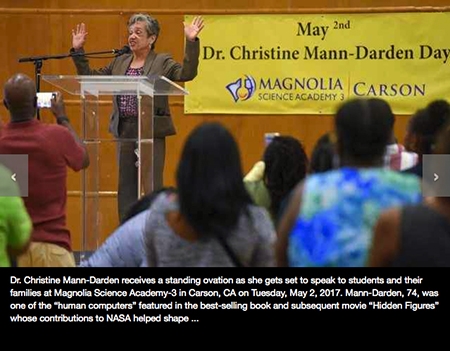

Hidden Figure: Pioneering black exec at NASA tells how she rocketed to success
Christine Mann-Darden, the first black female executive at NASA’s Langley Research Center and a scientist featured in the book “Hidden Figures,” has a formula for breaking glass ceilings.
Christine Mann-Darden, the first black female executive at NASA’s Langley Research Center and a scientist featured in the book “Hidden Figures,” has a formula for breaking glass ceilings.
“P to the fourth power,” she told Carson middle and high school students this week, is really a very simple credo: Perceive yourself in a job you like, plan how to get it, prepare for it, and persist.
She shared insights and stories about her life’s work in a Tuesday evening presentation to middle and high school students at Carson’s only independent charter school, Magnolia Science Academy 3.
“We saw the movie ‘Hidden Figures’ as a school,” said Shandrea Daniel, principal of the school for grades six through 12. Magnolia Public Schools have science, technology, engineering and mathematics-based campuses across Southern California. “We’re very excited and honored to have her here. You can’t beat this.”
Georgina Tlaxca, an eighth-grader, watched Mann-Darden’s speech with her family.
“When I grow up, I want to work at NASA, too,” Georgina said. “I find her inspirational. I want to find out more about the mysteries of the universe. I want to find out if anything came before the Big Bang.”
Students welcomed Mann-Darden with displays of their scientific research, including makeshift hovercrafts, robotics devices and science-fair-style poster board diagrams.
“When I was your age, I liked math and science, but we didn’t have a lot of it in school,” Mann-Darden told attendees. “When I went into 11th grade, I took geometry, and that’s what made me love mathematics. I decided I wanted to major in mathematics.”
A ‘HIDDEN FIGURE’
Mann-Darden wasn’t portrayed in the Oscar nominated film “Hidden Figures,” released last year starring Taraji P. Henson, Octavia Spencer and Janelle Monae. But her life story is part of the nonfiction book that the film was based on, documenting the first black women to obtain leading NASA aerospace jobs in the 1960s.
Once she realized her love for mathematics, Mann-Darden quickly learned that she didn’t have a lot of options to pursue in the field.
Her father told her he wouldn’t pay for her to study math in college because black women couldn’t get jobs in those professions in 1958.
“He said I had to get a teaching certificate,” she said. “But I had a formula in the back of my head: P to the fourth power. By this time, I had begun to perceive of myself in this mathematics job where I’m doing all this glorious work.”
PLANNING AND PREPARATION
The next steps in her formula were to plan how to prepare for and get a job she wanted while she obtained teaching credentials at Hampton Institute in Virginia.
First, she took all the elective math classes she could fit into her schedule. Then, after obtaining her first teaching job, she spent her free time taking math classes at Virginia State University.
After a few years, an opportunity opened up: A professor needed a research assistant in aerosol physics.
She jumped at it.
“That was a turning point in my life,” Mann-Darden said. “It meant I’d get a master’s degree. My thesis that year was measuring the reflections of different types of aerosols in the atmosphere. I really loved how mathematics was used to solve physical problems.”
A few years later, a dream opportunity opened up for her at the National Aeronautics and Space Administration. By then, she had all the college mathematics prerequisites.
Her plan had worked. She got a job as one of NASA’s human computers.
“Computer pools were no longer segregated,” she said. “I went into an integrated area. I wrote computer programs to solve equations. Then, I didn’t even know what engineers did because the only engineers where I grew up in Monroe, North Carolina, drove trains.”
She learned that engineers worked with the applied-math problems she loved so much: “That’s when I decided I want to be an engineer. I wanted to understand the entire question.”
PUSHING FOR PROMOTION
Her managers wouldn’t promote her, however. After a few tries, she got a meeting with a director and asked why women weren’t hired as engineers.
“He said: ‘You know, nobody ever asked me that question before,” Mann-Darden said. “I said, ‘Well I’m asking now.’
“He said a few other words about how many women left the workplace so quickly. And it was true that many of the white computers came there and married white engineers and went home. I said: ‘I think you’ll find that most African-American women will probably work longer.’ ”
He gave her the job. She began pursuing her doctorate and got her first engineering assignment to investigate sonic booms.
Since then, she’s led a team that developed a supersonic passenger jet that doesn’t create the disruptive “sonic booms” generated by breaking the speed of sound.
The research she spent decades developing with others at NASA is now being considered for federal funding, in the agency’s New Aviation Horizons initiative.
“We are very much involved in the budget to see if NASA is going to get that money,” Mann-Darden said.
“I had a wonderful career. If you want to work in math and science, go for it. Those of you who really do well, go for those top jobs in Silicon Beach, where the average salary is $200,000. And don’t forget to learn your math.”
http://www.presstelegram.com/social-affairs/2...
Source: Press-Telegram: Education